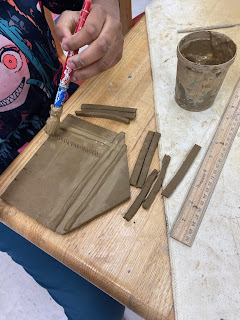I'm always trying to balance my art assignments between personal and collaborative projects. There's such a wide range of abilities within a group of students: a range of vision, a range of cognitive levels. It's nice, in group projects, for everyone to have a chance to do as much as they can, to contribute to something better than any one of them could do by themselves.
This is the third totem pole that we've made for the sensory garden on our school campus, and we may continue to make one every other year as long as interest prevails. I don't know. For the history of architecture totem pole, we started by brainstorming to come up with a list of famous buildings, most of which were chosen from student writing assignments. We talked a lot about which ideas made the most sense in terms of representing a range history? Which contemporary buildings are represent modernity and are recognizable symbols? Do we need to use both the Parthenon and the Pantheon? If we're going to do one, which should it be?
There were many problems to be solved. How do you stack pointy buildings? What should go on top? The pyramid of Giza? The Eiffel Tower? The Empire State Building? How do you use the ones that are not on top to help build a solid structure? How do you create a long skinny Great Wall of China in a way that will wrap around a pole? How do you create a straight tower that incorporates the Leaning Tower of Pisa? Art isn't just about going from point A to point B. Want a picture of a dog? Just draw a dog! It's not usually that simple. We seek to find the best possible solutions in a world of infinite possibilities.
And then there was the engineering? We didn't want all the skinny buildings on top on the bottom, but how do we arrange varied sizes and shapes in a way that is structurally sound? It turned out that the Taj Mahal sat more solidly on top of a thin pole with a bas relief of both Notre Dam cathedral and the Empire State Building than it did on top of the larger Parthenon sculpture. I hope my students could see the importance of playing around with, not only ideas, but of physical forms. Everyone pray that all of our buildings survive the kiln.















